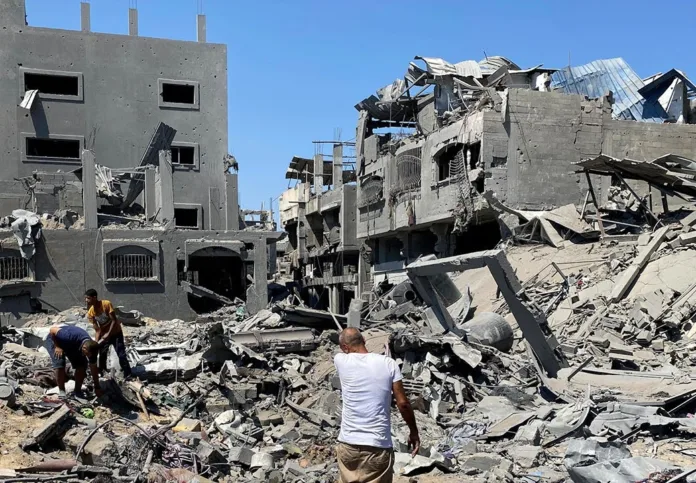Heavy shelling and ground incursions cause further displacement and destruction in Rafah and Shujayea
At least six Palestinians were killed in Gaza‘s southern city of Rafah as Israeli forces intensified their offensive, according to the Palestine Red Crescent Society (PRCS). The attacks have left several homes destroyed as Israeli tanks pushed deeper into Rafah and Shujayea in northern Gaza.
Israeli tanks, which re-entered Shujayea four days ago, have been firing shells towards houses, trapping families inside. “Our lives have become hell,” said 50-year-old Siham al-Shawa, a resident of Shujayea.
The United Nations Office for the Coordination of Humanitarian Affairs (OCHA) estimated that 60,000 to 80,000 people have been displaced from Shujayea in recent days. Those who remain face extreme danger, with strikes occurring unpredictably, making evacuation difficult.
Al Jazeera’s Tareq Abu Azzoum reported that residents who managed to flee Shujayea described the scale of destruction as “massive.” Central areas of Gaza City have also been heavily targeted, with at least 15 people killed in the north after their homes were hit by artillery shells.
In Rafah, indiscriminate attacks have forced residents to flee for their lives. Makeshift tent camps in the al-Mawasi district, declared a “safe zone” by Israel’s military, have been set on fire.
Speaking at a weekly cabinet meeting, Israeli Prime Minister Benjamin Netanyahu reiterated his commitment to continue the offensive until all objectives are achieved, including the elimination of Hamas and the return of Israeli hostages.
Despite efforts by Arab mediators and backing from the United States, ceasefire talks have stalled. Hamas official Osama Hamdan indicated no progress in negotiations, maintaining that any truce must end the offensive and ensure a full Israeli withdrawal from Gaza.
In the Israeli-occupied West Bank, one man was killed and five others wounded in an Israeli strike near Tulkarem. Hamas and allied Palestinian Islamic Jihad reported intense fighting in Shujayea and Rafah, with their fighters using antitank rockets and mortars against Israeli forces.
The Gaza health ministry reported that Israel’s offensive has killed at least 37,877 people so far, with 43 bodies arriving at hospitals in the last 24 hours and at least 111 others wounded.
Israeli operations in Rafah aim to eliminate the remaining armed battalions of Hamas. The offensive continues to severely restrict the entry of humanitarian aid, medicine, and fuel into Gaza, exacerbating the humanitarian crisis. The UN and other relief agencies have raised alarms over the dire conditions and imminent threat of starvation for Gaza’s 2.4 million residents.
“Everything is rubble,” said Louise Wateridge from the UN Relief and Works Agency for Palestine Refugees (UNRWA). “There’s no water, no sanitation, no food. People are living in buildings that are empty shells.”
Analysis:
Political Perspective: The ongoing conflict in Gaza reflects the deep-rooted and complex political tensions between Israel and Hamas. The heavy casualties and widespread destruction highlight the urgent need for a diplomatic resolution to prevent further humanitarian disasters.
Social Perspective: The displacement and suffering of civilians underscore the severe humanitarian impact of the conflict. The destruction of homes, and critical infrastructure, and limited access to essential resources have created a dire situation for Gaza’s population.
Economic Perspective: The ongoing blockade and destruction in Gaza have further crippled its economy. The restricted entry of goods and services exacerbates poverty and unemployment, making recovery and rebuilding efforts extremely challenging.
Historical Perspective: The current offensive is one of the deadliest in recent history, adding to the long-standing conflict between Israel and Palestinian groups. The historical context of territorial disputes, political power struggles, and failed peace processes continues to fuel the cycle of violence.
